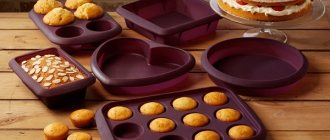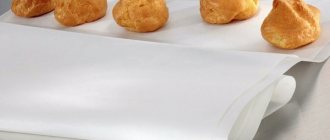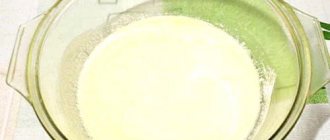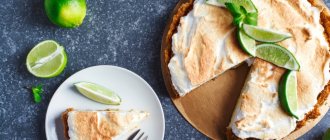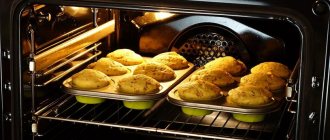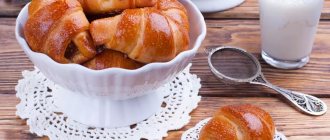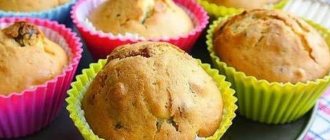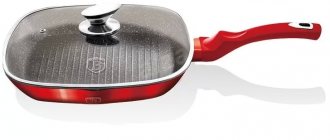Any cooking container requires compliance with certain rules during operation, and silicone molds are no exception. But, unlike metal or ceramics, this material is very unpretentious and, with proper care, will delight you with new culinary masterpieces for a long time. The main question for housewives starting to work with this unusual material is whether it is necessary to lubricate the silicone mold before baking?
Like any other baking material, silicone needs to be lubricated with oil or fat, but only before first use. The porous structure of the material will quickly absorb oil and retain it for a long time.
Before first use, thoroughly clean the inner surface. Often silicone molds have a complex pattern in which particles of dough can remain. To avoid this, turn the pan inside out so that the oil can get into the smallest imperfections.
How to use a silicone baking pan
The convenience of this material has captivated almost all housewives: silicone products can be stored very compactly, folded several times - this does not deform them. They are also easy to clean, no scrubbing required. You can remove food without any problems by simply turning the “dish” inside out, even if it is a fragile cake. Baking in a silicone mold is prepared faster than in a metal one: for comparison, a tall sponge cake with a diameter of 25 cm is baked in 40 minutes versus the usual hour. However, you need to use such kitchen utensils wisely - only then can they last for several (up to 5) years.
Basic rules:
- Immediately after purchase, you need to thoroughly clean the silicone mold using a soft sponge and detergent: you need to get rid of the chemical composition on its surface.
- After each use, go through the inside and outside with paper napkins or rinse it with clean water.
- Never try to clean silicone with hard brushes - this will damage the structure of the wall coating.
- It is easy to remove baked goods from the mold: pull the edges, lightly press on the bottom to push the food out. Some large pies need to be helped with a spatula, but it should be wooden or the same silicone. No metal!
- Do not place silicone on open fire.
- Do not store such utensils near sharp or sharp objects - holes and scratches on the silicone appear quickly.
Do I need to grease before baking?
This material is very convenient due to its non-stick feature, so you can bake in it completely without fat, which is ideal for dietary recipes. However, when using for the first time, the mold must be lubricated with oil to “activate” this property. Further, if the material is of high quality, it will perfectly maintain this condition itself. Cheap silicone may cause the dough to burn, which will require cooking with fats every time.
There are a couple of nuances here:
- It is advisable to lubricate with odorless vegetable oil - you should not use butter.
- If you decide to clean your silicone molds in the dishwasher or use detergent, you will need to re-oil the inside of them before baking anything again.
What to put in the oven
The fact that this material is very soft causes some difficulties when working with it. Housewives do not immediately understand how to put a silicone mold in the oven, and therefore use it in the same way as a metal one. You shouldn’t do this: for every silicone dish you need a mandatory stand: a similar form made of glass or ceramics, or a tray. This requirement is due to the ease of deformation of the bottom when placed on the grid. Additionally, there are a few more subtleties:
- If you are planning to bake a tall sponge cake, pudding or cake, the weight of a large amount of dough can cause the pan to tilt and tip over. Place it in a deep frying pan, pan, etc. that matches it in diameter.
- Fill the molds after they are placed on the stand, not before.
- Keep in mind that in a gas oven, the silicone product should not come into contact with the walls or open fire to prevent melting.
Life hacks, features, nuances, secrets
Some cooks use bran as a powder, especially suitable for baking bread. The rye product will become tastier. There are housewives who want to play it safe and lubricate silicone containers. Experts recommend evenly distributing fat in the following cases:
- if the container is equipped with grooved edges, convex places, recesses, tubercles and depressions;
- the dough itself turns out to be a bit dry and may crumble after cooking in the oven;
- the dough uses a large amount of sugar, jam, jam, honey and other ingredients that are prone to sticking;
- when using cookware for the first time after purchasing it;
- if baking utensils are washed in a dishwasher.
If the pastry chef bakes many portions of muffins or cookies in molds lined with parchment, it is recommended to cool the sheets between batches. If this is not done, the following products will burn. To cool the paper, place it under running water.
When baking pies and casseroles, you should choose a glass pan. It will allow you to monitor the dough, its rise and control its readiness.
How to bake in a silicone mold in the oven
Cooking with such molds is no more difficult than with ceramic, glass or steel. Choose a suitable design and you won’t even have to come up with decorations for a quick biscuit. Follow the basic rules given above, pour the dough, send it to the oven, microwave oven or multicooker. Silicone baking utensils are versatile and easy to use, especially if you consider these professional tips:
- Before cooking in a mold, rinse it and wipe it dry: it accumulates dust and static well, no matter where it is placed.
- Due to the high thermal conductivity of silicone, dishes are baked very well, so the optimal temperature will have to be selected again - it may be lower than usual.
- If this is your first time using a silicone mold, carefully monitor the dish: it will not take as long to cook as you are used to - the time will be reduced by approximately 15-20%.
- Check the manufacturer's information on the packaging: it may indicate at what temperatures a particular utensil should be used and where.
- Let the baked goods cool before removing them.
Is silicone harmful for baking?
Neither steel, nor ceramics, nor Teflon, nor glass have seen such a number of disputes regarding the safety of a material that comes into contact with food. They talk about the dangers of silicone for baking non-stop, each time putting forward new facts and hypotheses. However, where is the truth, and where is just an attempt to find a non-existent danger? Chemistry experts confirm that such products can have a negative effect on the body, but only if they are chosen and used incorrectly:
- Trying to save money, some manufacturers release molds made of “technical” silicone to the commodity market: a cheap material, often supplemented with low-quality dyes. As soon as they begin to heat up, harmful substances are released, which, together with the food inside the form, enter the human body.
- Medical or “food grade” silicone does not pose such a danger, no matter what temperature it is exposed to. It is suitable for both children's baking recipes and for preparing food for sensitive organisms - there is no release of harmful substances into the environment. However, in terms of safety, it still cannot be compared with ceramics or glass.
Reviews
Vasilisa
“Every weekend I bake raisin muffins for my husband and children. For us, this has already become a pleasant family tradition. Over several years I tried a lot of dishes, but for a long time I could not find the ideal one for myself. Either I didn’t like the unpleasant smell or the products that came out of it. My husband gave me a large uniform with several cells from , I was satisfied with everything. But it cannot be washed in the dishwasher. As soon as I did this, the dough immediately began to burn on it. Several times after that I had to grease it with oil, only after that the cupcakes stopped burning.”
Oksana
“I have a mold at home. Her husband says she is “unkillable.” At first I only cooked desserts, pies and cakes in it, then I started baking main courses of meat and vegetables. I recommend cooking in it. Firstly, they cook faster than in metal or ceramic dishes. Secondly, there is no need to add oil, which makes the dish lean and healthy.”
Silicone mold is the best kitchen assistant for a woman. But in order for it to live up to expectations and allow you to prepare beautiful and tasty culinary delights, you need to choose it correctly and cook in it. Taking into account all the nuances of this material.
How to choose a silicone baking dish
A housewife who has decided to diversify her culinary repertoire, but has not at all become familiar with the approximate characteristics of the “new kitchen residents,” will primarily make her choice based on external data. However, experts advise purchasing silicone baking molds not only based on general attractiveness or matching size and volume, but also taking into account some more important points:
- It was clarified above that the safe silicone product is made of medical material. This should be proven not by the manufacturer’s words on the label, but by the presence of a quality certificate. Its number is entered in the “composition” column, and upon request, the seller must hand over the paper to the consumer for review and confirmation of authenticity.
- The easiest way to determine the quality of a silicone mold is to listen to the aroma emanating from it. The pungent smell of rubber, plastic and other caustic chemicals should alert you and dissuade you from purchasing.
- If you purchased an odorless mold, but when heated, an unpleasant aroma develops, do not put it in the oven again: use it to cool desserts or freeze ice.
- An additional quality control method that gives a relatively reliable result: try bending the product before purchasing. There should not be a white mark at the folded area.
- If, after carrying out basic tests, you still have doubts, lean towards buying a product with a neutral (light) shade: acidic colors are obtained from caustic dyes, which are harmful to the body.
- The country of origin does not matter; today both Belarus and the USA offer a good selection, but ordering a whole bunch from Aliexpress, where no one guarantees high-quality silicone, is not recommended.
For cupcakes
There are several varieties of such a product, depending on what the chef will bake:
- A large muffin tin can be used for a cake if it looks like an inverted bucket, or for a tall ring sponge if there is a rod in the center. It is predominantly trapezoidal, the lower diameter (bottom) is in the range of 10-17 cm. The price ranges from 150 to 900 rubles, depending on the manufacturer and size. You can buy good products of this type from Mayer&Bosh, Tescoma.
- Small molds are designed for cupcakes and muffins, have a flat bottom and the same smooth or corrugated walls, the diameter ranges from 5 to 8 cm. Height - up to 9 cm. The capacity usually does not exceed 150 ml. The most inexpensive is a set of 3 pieces. from Mayer&Bosh for 160 rubles, or Horse (Russia) - for 215 rubles.
A muffin tin may look like a sheet with several (often an even number) cells that have a round base. This option is convenient because the baked goods will not turn over, because... all elements are connected. However, some housewives prefer single small products - this can be more economically profitable, because You can buy any quantity, not 6, 8 or 12 pieces.
- Trout baked in the oven - step-by-step recipes with photos
- How to prepare for an intestinal colonoscopy
- GPS beacon for children - reviews and prices. GPS trackers for children
For cakes
There are 2 options here: some housewives prefer to use shaped molds in the shape of a heart, star, fish, etc. They are useful for small sponge cakes that are cut and assembled after the base has cooled. For mousse desserts, professionals recommend detachable options - this silicone cake mold is completely identical in appearance to a metal one, but is more convenient to use. The best options in these categories:
- Among detachable ones, Lurch (from 1,499 rubles) and Bradex (from 690 rubles) deserve attention. The price may vary depending on the size and the presence/absence of an additional non-stick layer.
- Among the curly ones, the leader is Tescoma, offering large, beautiful products from 830 rubles, and Pyrex, which is in the same price range. They are also on the same level in terms of quality.
For cookies
Making products from thin dough in such kitchen utensils is not practiced for reasons of speed, because There are no particular problems with baking them on a metal baking sheet. A silicone cookie cutter is used primarily with recipes that do not require rolling out, i.e. for sumptuous delicacies. The same famous “madeleines” can only be made in special shell molds. Chefs often prefer to use such utensils for curly gingerbread cookies. Outwardly, it is similar to muffin baskets - also in the form of a sheet with several cells (6-12).
You can find interesting options at:
- Silikomart. The manufacturer also offers beautiful stamps that can not only be used to make thin cookies, but also chocolate decor, as in the photo of store-bought two-layer cookies. Cost – from 1190 rub.
- Best Home Kitchen. In addition to standard molds, you can find stamps with patterns at a budget price - from 130 rubles.
For baking bread
This design is a long rectangle that has minimal difference between the bottom and top perimeter. The silicone bread container has absolutely smooth walls and bottom, although there are varieties with slight corrugation. The following manufacturers offer such dishes:
- Mayer&Bosh – from 230 rub.;
- Oursson - from 840 rubles;
- Fissman – from 490 rub.
There are also options for small (up to 20 cm in length) baguettes, mainly in sheets of 4-9 pieces. – these are offered by the Spanish brand Lekue. You can also order bun molds (hemispheres) from him. The issue price is from 1850 to 2550 rubles. In the (official) online store, experts advise looking at portioned muffin tins: the quality of Lekue silicone products justifies the high price.
What are these products?
This is a universal container for baking a variety of flour products. In addition to their intended purpose, they are used for freezing food and desserts. All of them have a non-stick coating and can withstand different temperatures from -50° to +250°. Not a piece of baked dough remains on such a surface; after use, it is easily washed with running water and a sponge and is ready for the next use.
You can store such culinary assistants anywhere: they do not deform and do not take up much space. They can be placed inside each other, bent, rolled up, and if necessary, they instantly restore their original appearance.
Rating of silicone baking molds
If you understand what kind of delicacies you want to prepare, but are still lost in the variety of brands and prices, and cannot decide whose production is better - the USA or Austria, check out this rating of the best manufacturing companies:
- Marmiton. The brand's products are made in China, but the products are good value for money. Beautiful and comfortable shaped silicone molds can be found in Moscow stores at prices ranging from 110 to 700 rubles.
- Atlantis. A little-known but worthy Chinese brand. Molds can heat up to 240 degrees. A characteristic difference is the bright colors of all products. Price – from 460 rub.
- Tescoma. A well-known Czech company that offers a variety of silicone molds, even for pizza and pies. Temperature maximum – 230 degrees. Cost – from 350 rub.
- Oursson. From this Swiss brand you can find a large number of sheets with molds for cookies and chocolates at an affordable price: from 300 rubles.
- Fissman. The Danish manufacturer offers a wide range of beautiful molds for small curly cupcakes and children's casseroles. Cost – from 400 rub.
- Lekue. Made in Spain, the pricing policy is high, but the silicone is of excellent quality. This brand is the only one that offers interesting shapes for baguettes, rolls and bread. The asking price is from 1700 rubles.
- Regent. The brand is supposedly from Italy, but production is carried out in China. It cannot boast of a wide range, but there is plenty to choose from. There are even molds for pasta dishes (cannelloni, lasagna, etc.). Cost – from 300 rub.
- Taller. Mainly offers molds for muffins, bread, biscuits: simple designs, low price - from 300 rubles.
- Silikomart. Photos of the products of this mid-priced Italian company attract with their beautiful design: if you bake even the simplest sponge cake in them, it will already look festive. The disadvantage is that the price is not small: find an option cheaper than 1200 rubles. It won't work.
- De Buyer. The last place is due to the high cost of products - from 4600 rubles. per sheet for 6-9 products. But there is no need to question the French quality: such silicone has a long service life.
Results
Now you know whether silicone molds need to be greased with oil, how to cook in them correctly and basic care rules. Once you try to bake cupcakes or a pie in such a container at least once, you will no longer want to use any other options. Lightweight, flexible, of various designs and with any patterns, and at the same time quite inexpensive - they will quickly become familiar to you. You will never spoil the cake - everything, even the smallest details and designs, will easily separate from the walls without leaving marks. Cooking in such a cookware is a pleasure.
Any cooking container requires compliance with certain rules during operation, and silicone molds are no exception. But, unlike metal or ceramics, this material is very unpretentious and, with proper care, will delight you with new culinary masterpieces for a long time. The main question for housewives starting to work with this unusual material is whether it is necessary to lubricate the silicone mold before baking?
Like any other baking material, silicone needs to be lubricated with oil or fat, but only before first use. The porous structure of the material will quickly absorb oil and retain it for a long time.
Before first use, thoroughly clean the inner surface. Often silicone molds have a complex pattern in which particles of dough can remain. To avoid this, turn the pan inside out so that the oil can get into the smallest imperfections.
Classic cupcake recipe
A classic of the genre, it is this that is considered the basis for the preparation of all other variations. This recipe for small muffins has been known for centuries. Of course, today's version is significantly different from those that appeared in England many centuries ago, however, the modern interpretation of the recipe has already become a classic.
Components:
- Butter – 200 grams (can be replaced with the same amount of margarine);
- Flour – 1 glass;
- Sugar – 1-1.5 cups;
- Eggs – 4 pieces (if large, then 3 is possible);
- Baking powder – 1 teaspoon;
- Salt - a pinch;
You can use raisins or other berries and dried fruits, or chocolate chips as a filling. Their quantity depends only on your taste preferences.
Let's start cooking:
- After softening the butter, grind it with sugar until smooth and light. Then add eggs there, without stopping beating. This should be done in portions, adding one at a time and mixing.
- Then add the dry ingredients one by one. The flour must first be sifted. You can add any of the fillers you choose to the dough obtained in this way, and then mix it thoroughly. If using raisins, pour boiling water over them first and then sprinkle with a little flour. Such manipulations will help it spread throughout the dough without settling at the bottom.
- The baking temperature should be 180-200 degrees (depending on the oven), and in the meantime we distribute the dough into the molds, which we fill half or 2/3 full.
- They need to bake for about 20 minutes. Readiness can be checked using the method described above.
Curd joy
Everyone’s favorite cottage cheese muffins can be prepared not only in bulk form, but also by dividing them into small portions. It’s even more convenient, because each cupcake can be decorated separately, making the treat even more appetizing.
Components:
- Flour – 200 grams;
- Cottage cheese – 200 grams;
- Eggs – 2-3 pieces;
- Sugar – 150-200 grams;
- Butter – 150 grams;
- Baking powder – 1 teaspoon;
- Any filler - to taste.
The process of their preparation is not particularly complicated:
- Beat eggs with sugar into a homogeneous thick mass.
- Grind the cottage cheese through a sieve. It is advisable to take one that is not very wet and greasy, so the cake will turn out more airy. Then we add it to the egg mixture and mix.
- Melt the butter and add it to the dough base. Mix.
- Mix the sifted flour with baking powder and add to the dough, kneading it thoroughly. Spices and fillers are also added at this stage.
- Now distribute the dough into the molds, leaving 1/3 free. Place them in an oven preheated to 180 degrees for 25-30 minutes.
This delicacy can be served either warm or already cooled with sour cream, fruit sauces or powdered sugar.
Rules for selection and operation
Today, most hypermarkets sell many different molds made from this material. They differ in size, color, density, and geometric shapes. When choosing, you should focus primarily on the quality of the material. The denser it is, the longer it will serve its owner. Thin ones, of course, are much cheaper, but they are also impractical: they quickly wear out, tear, and the dough often sticks to the walls.
Next, the responsible buyer faces a difficult choice of color. You can be calm in this matter, since during production most well-known manufacturing plants use only safe dyes that do not affect the final quality of the dish. They do not lose their brightness due to sudden temperature changes or frequent washing. At the same time, the porous structure obliges the housewife to thoroughly rinse all corners after each use with an anti-grease detergent.
Storing them is quite simple: if there is no special cabinet in the house, they are stacked or rolled.
Over time, the container may lose its original shape, become discolored, its surface loses its gloss and shine, and becomes friable - this is the main indicator of the need to get rid of it and buy a new one.
What to lubricate with?
The choice of oil should be taken responsibly, as the wrong product can spoil the taste of the dish.
Vegetable oils
Most often, sunflower oil, always refined, is used to lubricate the baking sheet. Why? The aroma of sunflower or olives makes baked goods less appetizing. Some people use sesame or flax oil. But in this case, you should be careful, because these products have a short shelf life and a bitter taste.
Butter, margarine, spread
Soft butter is best, because it forms a golden brown crust and gives baked goods a pleasant aroma. You can also use margarine, which has no odor. The downside of these options is the calorie content. The same applies to spread (made from milk fat, vegetable oil and other ingredients).
Chocolate cupcakes
Using this recipe, you can prepare delicious and fragrant muffins in a short time and without much hassle.
The cooking sequence will be as follows:
- Sift flour and sugar (2 tbsp each), cocoa powder (1 tbsp), soda (2 tsp), baking powder and salt (1 tsp) into a deep bowl.
- Add 2 eggs to the dry ingredients, as well as a glass of water and kefir, vegetable or melted butter (½ tbsp.).
- Preheat the oven to 180°.
- Place paper muffin tins in metal cupcake tins. Pour the batter inside.
- Place the cupcakes in the hot oven for 25 minutes.
If desired, you can decorate the cooled products with cream cheese cream or Swiss meringue.
